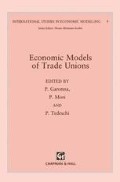Abstract
But union members are different from nonmembers in unobserved ways, biasing your estimates. Y ou should ... make a selectivity bias correction ... simultaneously determine union status and economic outcomes ... develop an unobservables model ... USE LONGITUDINAL DATA. (Archetypical comment on virtually any study of the economic effects of umomsm, or suitably modified, on any other empirical subject.)
Access this chapter
Tax calculation will be finalised at checkout
Purchases are for personal use only
Preview
Unable to display preview. Download preview PDF.
References
Abowd, J. M. (1983) Comments on the Effects of Selectivity, Biases on Estimates of Union/Non-union Effects in a Panel Setting. In Review of Longitudinal Analyses of the Effects of Trade Unions (ed. Richard Freeman), University of Chicago, Chicago, (Mimeo).
Abowd, J. M. and Farber, H. S. (1987) Job queues and the union status of workers. Industrial and Labour Relations Review, 35, 354–67.
Aigner, D. J. (1973) Regression with a binary independent variable subject to errors of observation. Journal of Econometrics, 1, 49–60.
Brown, C. (1980) Equalizing diferences in the labor marker. Quarterly Journal of Economics, 94, 113–34.
Chamberlain, G. (1982) Multivariate regression models for panel data. Journal of Econometrics, 18, 5–46.
Chowdhury, G. and Nickell, S. (1982) Individual earnings in the US: another look at unionization, schooling, sickness and unemployment using panel data, Discussion Paper 141, Centre for Labour Economics, London School of Economics, London.
Donsimoni, M-P. J. (1978) An Analysis of trade union power: structure and conduct of the American labor movement, Ph.D. thesis, Harvard University, Cambridge, MA.
Duncan, G. J. (1976) Earnings functions and nonpecuniary benefits. Journal of Human Resources, 10, 462–83.
Duncan, G. J. (1977) Paths to Economic Well-Being, in Five Thousand American FamiliesPatterns of Economic Progress, (eds G. J. Duncan and J. N. Morgan), Institute for Social Research, Ann Arbor, MI.
Duncan, G. J. (1979) An Empirical Model of Wage Growth, in Five Thousand American Families-Patterns of Economic Progress, (ed. G. J. Duncan and N. Morgan), Vol 7, Institute for Social Research, Ann Arbor MI.
Freeman, R. B. (1980) Unionism and the dispersion of wages. Industrial and Labor Relations Review, 34, 3–23.
Freeman, R. B. (1981) The effect of trade unionism on fringe benefits. Industrial and Labor Relations Review, 35, 489–509.
Freeman, R. B. (1982) Union wage practices and wage dispersion within establishments. Industrial and Labor Relations Review, 36, 3–21.
Freeman, R. B. (1983) Unionism, pensions, and union pension funds, Paper presented to National Bureau of Economic Research Conference on Pensions, Labor, and Individual Choice, 23–26: New York.
Freeman, R. B. and Medoff, J. L. (1981) The impact of collective bargaining: illusion or reality? in US Industrial Relations 1950-1980: A Critical Assessment, (eds by J. Steiber, R. McKersie, and Q. Mills), Industrial Relations Research Association, Madison, WI.
Goldstein, G., and Pauly, M. (1976) Group Health Insurance as a Local Public Good, in The Role of Health Insurance in the Health Services Sector, (ed. Richard N. Rosett), National Bureau of Economic Research, New York.
Hirsch, B. (1982) The interindustry structure of unionism, earnings and earnings dispersion. Industrial and Labor Relations Review, 36, 22–39.
Hyclak, T. (1977) Unionization and urban differentials in income inequality. Journal of Economics, 3, 205–7.
Hyclak, T. (1979) The effect of union on earnings inequality in local labor markets. Industrial and Labor Relations Review, 33, 77–84.
Leigh, D. E. (1981) The effect of unionism on workers’ valuation of future pension benefits. Industrial and Labor Relations Review, 34, 510–21.
Lewis, H. G. (1983) Fixed Effects or Measurement Errors in Panel Data, Graduate School of Business, Duke University, Durham, NC.
Marquis, K. H., Duan, N., Marquis, M. S., Polich, J. M. Meslkoff, J. E., Shwartzbach, D. S. and Stasz, C. M. (1981) Response Errors in Sensitive Topic Surveys: Estimates, Effects, and Correction Options. Rand/R-271012-HHS. Rand Corporation, Santa Monica, CA.
Mellow, W. (1981) Unionism and wages: A longitudinal analysis. Review of Economics and Statistics 63, 43–52.
Mincer, J. (1982) Union Effects: Wages, turnover, and job training. NBER Working Paper 808, New York.
Plotnick, R. D. (1982) Trends in male earnings inequality. Southern Economic Journal, 48,724–32.
Solnick, L. M. (1978) Unionism and employer fringe benefit expenditures. Industrial Relations, 17, 102–7.
Viscusi, W. K. (1980) Unions, labor marker structure and the welfare implications of the quality of work. Journal of Labor Research, 1, 175–92.
Editor information
Editors and Affiliations
Rights and permissions
Copyright information
© 1992 Springer Science+Business Media Dordrecht
About this chapter
Cite this chapter
Freeman, R.B. (1992). Longitudinal analyses of the effects of trade unions. In: Garonna, P., Mori, P., Tedeschi, P. (eds) Economic Models of Trade Unions. International Studies in Economic Modelling. Springer, Dordrecht. https://doi.org/10.1007/978-94-011-2378-5_6
Download citation
DOI: https://doi.org/10.1007/978-94-011-2378-5_6
Publisher Name: Springer, Dordrecht
Print ISBN: 978-94-010-5049-4
Online ISBN: 978-94-011-2378-5
eBook Packages: Springer Book Archive

